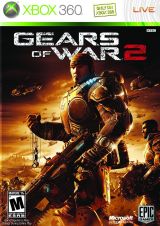Rod Fergusson: It's a mix of things. When you're looking at a character, you have to ask yourself what you're trying to get out of them. For instance, the new Carmine, Benjamin Carmine, serves the purpose of being the rookie that needs stuff explained to him, similar to what we just talked about. That's an old way to trick the player, having someone green on your squad. It provides an interesting emotional reaction to, as opposed to the battle hardened veteran who doesn't really react to anything. You want that guy who's screaming and upset or whatever.
That was sort of the same thing that we thought about Tai. We wanted another battle-savvy Gear, someone who's known Marcus since the Pendulum Wars, but we had to think of another archetype. What's another way to make another cool character that's not too similar to Marcus or Dom? This idea of a Pacific Islander warrior who's a bit more spiritual and a bit more about the honor system. It was a nice twist and he offered a cool visual style as well.
Then, with Dizzy, he played into the idea in the world of conscription. There are these Stranded that are out there, and they've chosen freedom over security, they don't want to be part of the COG, they want to survive on their own. At some point, some of them might go, "This is too much, I've got my twin daughters, I've got my wife, and I don't want to see anything happen to them. I am going to trade my freedom for my security and I'm going to become this conscript and do whatever I can to help the war effort. In this case, it's driving this big truck." So, you just sort of try to reinforce the backstory behind the world. As we kind of flesh Dizzy out as a character, with his truck driver ways and some of the characterization that he has, we really latched onto him and tried to develop him more and more.
GameSpy: Let's talk about some of the environments. The buzzwords surrounding the first game were "destroyed beauty", but it seems like this time you really focused on a wider variety of environments. Was this a conscious decision, given that some people complained that the first game lacked that variety?
Rod Fergusson: Well, it certainly wasn't a reaction, we were very happy that we nailed what we were going for in the first game. The desaturated look and the "Band of Brothers" thought that red blood on a desaturated world means more. When we were planning, we thought about where interesting places to go would be, and we did think about the mountain hamlet and that we wanted to go underground and see the Locust Hollow and check out some of the Locust architecture, then we want to go to a forest to bring that extra contrast. We really weren't countering any feedback on the first game, it was just sort of where our design sensibilities were. Because we knew were we wanted to go, we were able to leverage a far greater palette, and we brought the greens and the oranges and the blues there as well.GameSpy: Yeah, it seems a lot more colorful, I was amazed at how vibrant and bright some of the stuff underground was. There was a different look in each of the environments, in some you saw Ruins, in others we saw slimy tendrils, and one part featured a lot of water. You guys showed that off a bit at GDC, where you said that Unreal Engine 3 would have better water effects and crowd dynamics. Were these added in part for Gears of War 2 2?
Rod Fergusson: Yeah, for the most. There's some give and take. The engine has things that we'll look at from a technology standpoint and decide how we're going to leverage that, but it also goes the other way. Traditionally over the life of the Unreal Engine, we've developed the engine in such a way that it supports the games we're making. Our perspective is that if we don't use the feature we're building, we may never know if it's actually good. So, if we were to build a feature that we don't even use in our own games it might just sit there and rot, and we won't know if we have to optimize it or what. We tend to focus on building into the engine what features we need to drive our game. One of the things we looked at in Gears 1 was our fluid dynamics, and we decided that we wanted to improve those. That allowed use to look at doing a number of different things when it comes time to utilize that.





